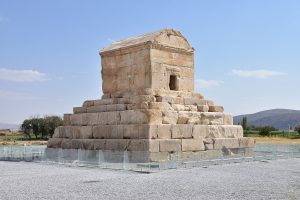The Tomb of Cyrus the Great is a stone monument that houses the remains of Cyrus the Great, the founder of the first Persian empire called the Achaemenid Empire. The mausoleum was built in Pasargadae, formerly the capital of the ancient Achaemenid Empire. Presently, it is located in the Fars Province of Iran, preserved as an archaeological site and cultural heritage site.
Cyrus the Great
Cyrus the Great, also referred to as Cyrus II, was the first king of the Achaemenid dynasty and the fourth king of Anshan. He was born sometime in 600 BC in the ancient Persian city of Anshan. The famous Persian ruler had various military successes against the biggest kingdoms of his period, such as the Median, Lydian, and Neo-Babylonian empires. His campaigns culminated in the unity of the Middle East under Persian rule.
Physical Description
The monument comprises two parts: one six-step platform made of stone and one room with a gable roof that stands on the sixth step. The highest that it measures is 11 meters. Its walls are thick, constructed from ashlar blocks held in place by “dovetail” clamps.
Historical Descriptions
One of the earliest accounts regarding the Tomb of Cyrus is provided by the Greek historian Aristobulus. He joined Alexander the Great, the king of Macedon, in his military campaigns in the East. Although Aristobulus’ writings are lost, the Greek commander and historian named Arrian used his predecessor’s information in his work.
The monument’s foundation was made of square tiles that formed a rectangle. A stone building with a roof stood on the base, an extremely narrow door serving as its entry point. Within the structure, laid in a golden coffin, is the deceased founder of the Persian empire.
Aristobulus described a couch beside the coffin, its feet made of gold, while a carpet lay beneath, displaying a Babylonian tapestry. Several pieces of clothing also lay on the couch, such as trousers, collars, and multicolored robes. Outside, various trees surrounded the mausoleum while the rest of its foliage was watered by the stream nearby.
The second time Aristobulus visited the tomb, it was robbed of the body and the valuable possessions beside it. Arrian wrote that he was furious upon learning that the son of the second Achaemenid king pillaged the tomb that stood in the royal park of Pasargadae.
On the tomb, the Persian inscription read: “O man, I am Cyrus, son of Cambyses, who founded the empire of the Persians and was king of Asia. Do not, therefore, grudge me this monument.”
Acorrding to the Greek historian Strabo, when Alexander the Great invaded Persia in 334 BC , he visited the mausoleum of Cyrus and asked Aristobulus, one of his soldiers, to enter the tomb first. He found the gold coffin, jewels, drinking vessels, and the inscription that is no longer evident in the modern-day site.
After the Arab conquest in 642, the tomb was also identified as the “Tomb of Madre Suleiman,” the resting place of Sulayman ibn Abd al-Malik, the seventh Umayyad caliph, or as the mausoleum for the biblical figure Bathsheba, mother of Solomon. The site then became a pilgrimage location for women worshipers.
The Venetian traveler Giosafat Barbaroor and the 17th-century explorer Johan Albrecht de Mandelslo found the tomb during voyages. Later, in the 19th century, the diplomats James Justinian Morier and then Robert Ker Porter claimed it was Cyrus’s tomb. During that period, several historians who visited the site discussed the presence of pillars on the site. Ker Porter journeyed to the monument in 1818, saying that 24 pillars went around the tomb. Next, the German researcher Franz Heinrich Weisbach explored Pasargadae at the time and also affirmed the existence of pillars in the area.
Renovations
The tomb of Cyrus the Great was renovated in 1972 by the head of the Persepolis Archaeological Institute, Ali Sami. More restoration work was done in 2002, which cultural heritage experts have claimed damaged the structure. After which, Persepolis sent an expert group to investigate the damages and confirmed the restorer’s lack of experience and expertise.
The Tomb of Cyrus the Great underwent restoration from 2002 to 2008. It is where Cyrus the Great Day is celebrated every year on the 7th Aban on the Iranian calendar or October 29th, although this is an unofficial holiday.
